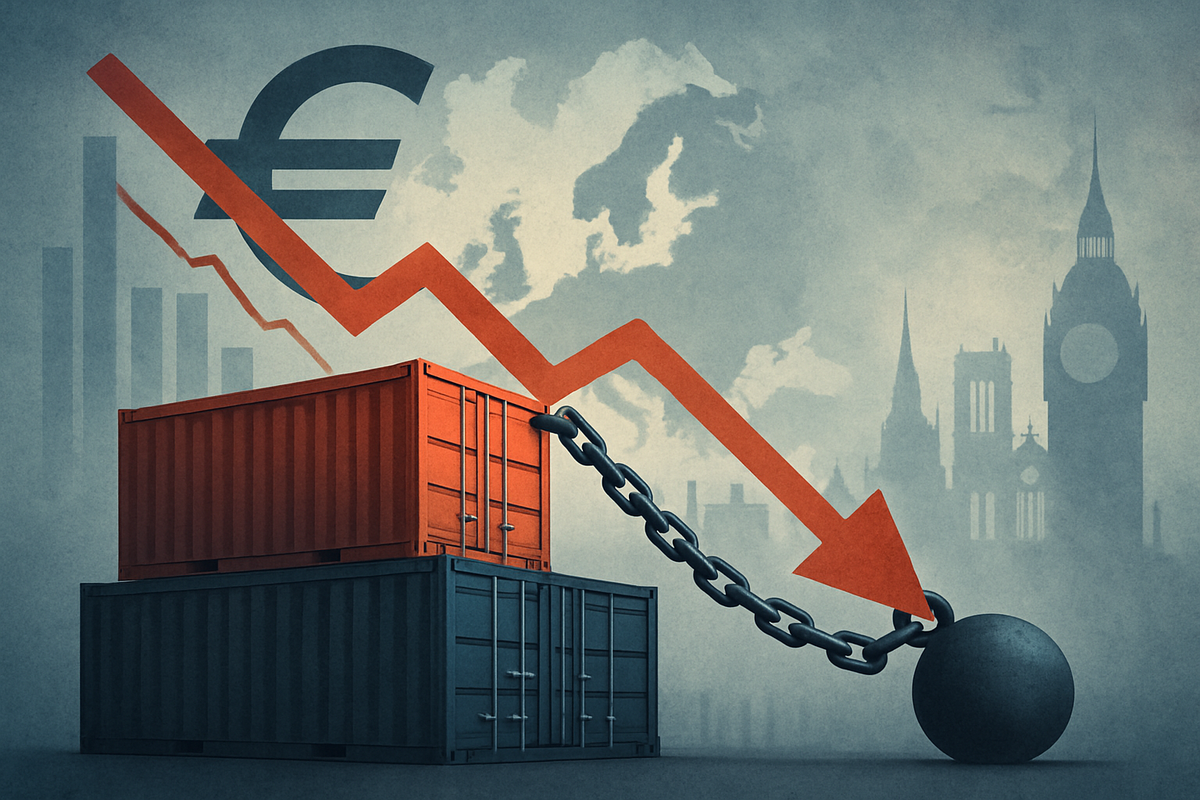
The Eurozone's balance of trade has recently shown a concerning contraction in its surplus, signaling potential economic headwinds for the bloc. After a period of significant deficits in 2022, the region had managed to restore a surplus, but recent data reveals a sharp narrowing, with August 2025 recording a mere €1.0 billion surplus, a dramatic drop from July's €12.7 billion and August 2024's €3.0 billion. This unexpected shortfall is likely to dampen economic sentiment, particularly impacting export-oriented industries and raising questions about the Eurozone's resilience in a volatile global trade landscape.
This shift comes as the Eurozone grapples with lingering effects of past energy price shocks, weakening global demand, and persistent trade policy uncertainties. The cumulative trade surplus for January to August 2025 also decreased compared to the previous year, suggesting a broader trend rather than an isolated incident. The immediate implication is a revised downward outlook for economic growth, with the European Central Bank (ECB) and Eurostat projecting modest GDP growth for 2025, largely due to these export challenges and investment hesitations.
A Closer Look at the Eurozone's Trade Erosion
The latest figures from August 2025 paint a stark picture: Eurozone exports of goods to the rest of the world declined by 4.7% year-on-year to €205.9 billion, while imports also fell by 3.8% to €204.9 billion. This dual contraction, with exports falling more sharply than imports, underscores a weakening global demand environment coupled with internal structural challenges. The significant decrease in the overall balance of trade, moving from a substantial surplus to a near-equilibrium, reflects a fragile economic recovery.
The genesis of the Eurozone's trade woes can be traced back to a critical period between the fourth quarter of 2021 and the third quarter of 2022. During this time, the region's long-standing trade surplus evaporated, plunging into a record deficit of €54.9 billion in August 2022. This dramatic reversal was primarily fueled by the unprecedented surge in commodity prices, particularly energy and food, exacerbated by the Russian invasion of Ukraine. The subsequent scramble for alternative energy sources and the associated costs sent import bills soaring. While the immediate energy crisis has somewhat subsided, its structural impact on Eurozone industry, particularly manufacturing, remains a significant headwind.
More recently, the narrowing surplus in 2024 and 2025 is attributed to several factors. Weakening export performance is a key driver, with notable declines in exports to major partners such as China (-12.8%), Japan (-24.9%), and the US (-22.3%) in August 2025. Key sectors like chemicals (-9.6%) and machinery and vehicles (-3.9%) have been particularly hit. Furthermore, earlier in 2025, rising import volumes in certain categories like food & drink and chemicals also contributed to the erosion of the surplus. Persistent trade policy uncertainties, especially with the United States, and structural headwinds in the manufacturing sector, including high energy prices and increased competition, particularly from China's industrial over-production, continue to weigh on the Eurozone's trade balance. The European Commission's Q1 2025 data already indicated a widening Eurozone trade deficit of €45 billion, foreshadowing the current trend.
The immediate market reaction to these figures, though not explicitly detailed as a single event, has been a growing sense of caution. The European Central Bank has already revised its GDP growth projections downward, reflecting concerns over weaker exports and investment. Export-driven sectors, which typically benefit from a healthy trade surplus, are now facing increased scrutiny and potential negative sentiment on stock markets. The vulnerability of Eurozone exporters to shifts in global supply chains and ongoing tariff negotiations with key partners like the US is becoming a critical point of concern for investors and policymakers alike.
Public Companies Brace for Impact: Winners and Losers in a Shifting Trade Landscape
The contraction of the Eurozone's trade surplus is poised to create a distinct cleavage between public companies, with export-oriented giants likely to bear the brunt of the downturn, while a select few might find unexpected opportunities. The most immediate casualties are expected to be in the automotive, chemicals, and machinery sectors, which have seen significant declines in exports to key markets.
Major automotive manufacturers, with their extensive global supply chains and reliance on international sales, are particularly vulnerable. Companies like Volkswagen AG (Frankfurt Stock Exchange: VOW), Mercedes-Benz Group AG (Frankfurt Stock Exchange: MBG), and Bayerische Motoren Werke AG (BMW) (Frankfurt Stock Exchange: BMW) face headwinds from reduced demand in non-Eurozone markets, particularly China and the US, coupled with ongoing trade policy uncertainties and potential tariffs. Stellantis N.V. (Euronext Paris: STLA, Borsa Italiana: STLA, NYSE: STLA), with its significant European manufacturing base and exposure to US brands, has already highlighted the substantial costs that tariffs could incur. These companies must now navigate a complex web of declining orders, disrupted supply chains, and evolving trade relationships.
Similarly, the chemicals and machinery sectors, critical pillars of Eurozone industry, are feeling the pinch. BASF SE (Frankfurt Stock Exchange: BAS), the world's largest chemical producer, will likely see its revenues and growth prospects challenged by declining chemical exports, especially to major partners. Bayer AG (Frankfurt Stock Exchange: BAYN), though diversified, has significant exposure through its chemicals and agricultural solutions segments. In machinery, industrial giants like Siemens AG (Frankfurt Stock Exchange: SIE), which exports a wide array of equipment, could see its industrial automation and digital industries segments negatively affected by reduced global investment and demand. MTU Aero Engines AG (Frankfurt Stock Exchange: MTX), a German aircraft engine manufacturer, has already reported financial hits from tariffs and supply chain restructuring, issues that a continued trade decline would exacerbate.
However, not all companies face a bleak outlook. A potentially weaker Euro, often a consequence of a deteriorating trade balance, could offer a silver lining for Eurozone-based companies that generate substantial revenue in stronger foreign currencies while incurring costs in Euros. Airbus SE (Euronext Paris: AIR), a major aerospace manufacturer, sells aircraft globally, often priced in US dollars. A weaker Euro would make its products more competitive and boost the Euro-denominated value of its foreign sales. Similarly, luxury goods conglomerates like LVMH Moët Hennessy Louis Vuitton SE (Euronext Paris: LVMH), with significant international sales, could see increased profitability as their products become more attractive to foreign buyers and their overseas earnings translate into higher Euro figures. Furthermore, companies with a strong domestic or intra-Eurozone focus, such as building materials provider CRH plc (Euronext Dublin: CRH, NYSE: CRH) or hospitality group Accor SA (Euronext Paris: AC), might prove more resilient or even gain if internal demand shifts away from more expensive imports or if intra-European travel becomes more appealing.
Wider Significance: A Confluence of Global Pressures
The significant decrease in the Eurozone's balance of trade is not an isolated economic blip but rather a symptom of deeper, interconnected global trends and structural shifts. This event fits squarely into a broader narrative of global trade slowdown and potential deglobalization, where geopolitical tensions, protectionist policies, and the restructuring of supply chains are reshaping international commerce. The Eurozone, a historically export-driven economy, is particularly susceptible to these forces.
The ripple effects of a shrinking trade surplus are extensive. For supply chains, it implies continued stress, as companies may seek to re-shore production or diversify sourcing away from traditional partners to mitigate risks associated with trade disputes and geopolitical instability. This could lead to higher production costs in the short term. On the consumer front, persistent trade imbalances and import cost pressures could fuel inflation, eroding purchasing power and potentially leading to a slowdown in consumer spending. The weakening export performance also impacts industrial output and employment in key manufacturing nations within the Eurozone.
Regulatory and policy implications are substantial. The European Central Bank (ECB) faces a delicate balancing act. While a weaker Euro might aid exporters, it also makes imports more expensive, potentially exacerbating inflation. The ECB's monetary policy decisions will need to carefully consider these trade dynamics, alongside domestic inflation and growth targets. Furthermore, Eurozone policymakers are likely to intensify efforts to diversify trade relationships, reduce reliance on single markets or suppliers, and potentially explore new trade agreements to bolster economic resilience. Discussions around industrial policy, aimed at strengthening domestic production and innovation, are also expected to gain traction.
Historically, periods of significant trade deficits or rapidly shrinking surpluses have often preceded or accompanied economic slowdowns. For instance, the Eurozone's deficits in 2022, primarily due to energy shocks, contributed to fears of a recession. While the current situation is a narrowing surplus rather than a deep deficit, the underlying causes—weakening global demand, competitive pressures from countries like China, and trade policy frictions—bear similarities to past episodes where external trade became a drag on economic growth. Comparisons can be drawn to periods of heightened trade tensions between major global blocs, where retaliatory tariffs and non-tariff barriers have disrupted established trade flows and negatively impacted multinational corporations. The current environment suggests a shift from an era of relatively open global trade to one characterized by increased fragmentation and strategic competition, demanding a fundamental reassessment of trade strategies by both governments and businesses.
What Comes Next: Navigating Uncertainty
The path forward for the Eurozone's trade balance and its broader economy is fraught with both challenges and potential for strategic adaptation. In the short term, the Eurozone is likely to continue experiencing subdued economic growth, as export challenges persist and global demand remains tepid. The risk of a technical recession cannot be entirely discounted if external pressures intensify and domestic demand fails to pick up significantly. Companies in affected sectors may face continued pressure on profit margins, leading to potential cost-cutting measures, including workforce adjustments.
In the long term, the Eurozone's trajectory will depend on its ability to implement strategic pivots and adaptations. This includes a concerted effort to diversify export markets beyond traditional partners like the US and China, exploring growth opportunities in emerging economies. Companies will need to accelerate the re-shoring or friend-shoring of supply chains to enhance resilience against geopolitical shocks and trade disruptions, even if it entails higher initial costs. Investment in green technologies and digital transformation could also provide new avenues for competitive advantage, aligning with broader European policy goals.
Market opportunities or challenges will emerge from these shifts. While export-heavy industries face headwinds, sectors focused on domestic consumption, sustainable technologies, or those benefiting from a potentially weaker Euro could see relative gains. Investors will need to carefully evaluate companies' exposure to international trade and their adaptability to a more fragmented global economy. The current environment presents a challenge for traditional growth models, prompting a re-evaluation of investment strategies towards resilience and diversification.
Potential scenarios range from a continued gradual erosion of the trade surplus if global economic slowdowns persist and trade tensions escalate, to a stabilization or modest improvement if global demand recovers and Eurozone industries successfully pivot to new markets and products. A more pessimistic scenario could see a return to trade deficits if energy prices surge again or if protectionist measures severely curtail Eurozone exports. The most optimistic scenario involves a successful reorientation of Eurozone trade, leveraging its technological strengths and internal market to foster sustainable growth, despite external challenges.
Comprehensive Wrap-Up: Resilience in a Fragmented World
The significant decrease in the Eurozone's balance of trade serves as a potent indicator of the profound shifts occurring in the global economic landscape. The key takeaways from this event are clear: the era of robust, easily accessible global markets for Eurozone exporters is facing unprecedented challenges, driven by geopolitical tensions, structural energy price impacts, and intensifying international competition. The August 2025 figures, showing a dramatically narrowed surplus, underscore the urgency for proactive measures.
Moving forward, the market will likely be characterized by increased volatility and a premium on corporate adaptability. Companies that can swiftly adjust their supply chains, diversify their customer base, and innovate within the confines of a more regionalized or strategically aligned global trade system will be best positioned to thrive. The Eurozone's economic resilience will be tested, requiring a delicate balance of internal policy support and external diplomatic engagement to secure its trade interests.
The lasting impact of this trade rebalancing could be a more inward-looking, yet potentially more resilient, Eurozone economy. While the immediate outlook suggests slower growth and increased pressure on export-dependent industries, it also presents an opportunity for the bloc to strengthen its internal market, foster domestic innovation, and strategically re-evaluate its role in a fragmented global economy.
What investors should watch for in coming months includes further data on trade flows, particularly with major partners like the US and China, and signs of recovery in key export sectors such as automotive and chemicals. Monitoring the European Central Bank's policy responses, government initiatives to support trade diversification, and the evolution of global trade agreements will be crucial. Furthermore, investors should pay close attention to the earnings reports of multinational corporations with significant Eurozone exposure, looking for signs of strategic adjustments and their impact on profitability. The ability of the Eurozone to navigate these turbulent trade waters will be a defining factor for its economic health in the years to come.
This content is intended for informational purposes only and is not financial advice






